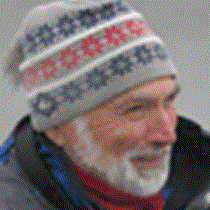Like the finale in an energetic symphony, Baja California's magnificent coastline ends in an exuberant crescendo of wave-battered scenery. This photo shows Lands End, or La Finestera. Billions of ocean swells over millions of years have rolled along in the Pacific and crashed headlong into this landmark. Sand acting like tiny chisels has been violently thrown against this rock by tons of water. Each crack and weak spot has been worked over by huge seas, occasionally driven by hurricane-force winds. It takes a very resistant rock like granite to defy this onslaught and stand so erect and prominent.
The La Paz fault defines the southern tip of the peninsula. This "cape" region has moved upward and shifted to the east. Baja California's backbone is made up of granite, but much of it is covered by other rocks. The uplift of the cape has allowed volcanic layers that once lay above it to be eroded away exposing the granite. Possibly no other place in Baja has such rich history. Behind these same rocks pirate ships hid and waited for Spanish galleons traveling from the Philippines to Spain's empire in central Mexico. What a place for a surprise attack by ruthless knife-wielding thieves. Offspring of these tyrants later murdered missionaries and their followers.
As was described in the log from the Sea of Cortez, John Steinbeck and Ed Rickets motored into this bay one night looking for a harbor light and a place to stop. They could not find the navigational aid and had to anchor nearby. It wasn't until the next morning when the cannery generator was started that the light came on.
The M. V. Sea Lion rounded the cape this morning at 7 a.m. after a night of following seas. Many of us went snorkeling at Pelican Rock after breakfast. Bright blue-spotted immature damselfish and Moorish idols were the most conspicuous fish, as well as king angels and schools of yellow-tailed surgeons. During our bird walk we spotted verdins, hooded orioles, and gila woodpeckers, and even an unusual black-headed grosbeak. Other guests took part in a shopping tour that emphasized little known but rather interesting local shops. Some even found the pirates that still lurk in the "Cabo" shadows.
During lunch, our ship sailed into the Sea of Cortez in search of more adventures. Humpback whales swam so close that we could see their 40-ton bodies and light-colored pectoral fins through the clear water. These leviathans are members of a feeding stock that summers off the productive, upwelling waters of California. Research using individually identified whales shows that both these and those found from Hawaii to Alaska are recovering well. As evening drew near we turned north toward new adventures in the Sea of Cortez.




